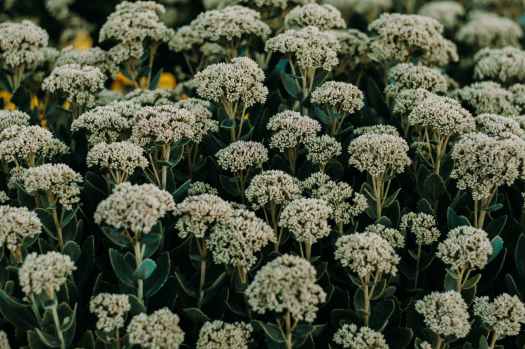
Love Lies Bleeding‘s readers know that main character Mara is both a vampire and a botanist. Trained when she was still human, she continues to study plants and have a garden. This post is sixth in a series exploring Mara’s plants. Are you interested in botany, gardening, or plant lore? So are some vampires…
Please note: Medicinal uses are given for informational purposes only. Always consult a medical professional before diagnosing or treating yourself or anyone else.
Botanical Name: Achillea millefolium
Common Names: Common yarrow, sanguinary, bloodwort, plumajillo (“little feather”). nosebleed plant, old man’s pepper, devil’s nettle, milfoil, soldier’s woundwort, thousand-leaf, staunchweed, arrowroot, field hops, woundwort. An old name for Yarrow is herba militaris.
History: Native to temperate regions of the Northern Hemisphere, yarrow has now spread around the world, growing freely along roadsides and coastal areas and in fields and meadows. It’s been used medicinally since prehistoric times, including by Neanderthals. Ancient Hellenes (Greeks) used it to stop bleeding from wounds (the name Achillea comes from the hero Achilles, who supposedly took yarrow into battle to treat his soldiers). Indigenous tribes throughout North America used the herb medicinally for pain relief, fever reduction, and as a sleep aid, among other things. In the Middle Ages it was used along with other herbs to flavour beer before hops became prevalent (it’s still used in beer-making in Sweden). In the Hebrides it was believed that holding a leaf against the eyes would bestow second sight. In China the dried stalks have been used for centuries in divination.
Victorian Language of Flowers Meaning: Healing, protection
Cultivation: Perennial in Zones 2 to 8. Yarrow is ideal for native plant gardens, drought tolerant gardens, and wildlife gardens. Prefers full sun and well-drained soil, but is tolerant of many conditions. Can grow up to 1 metre (approx. 3 feet). Seeds require light, a moist environment, and cool temperatures to germinate, so sow outdoors, barely covered by soil, after the last frost date; or start indoors 6 to 8 weeks before last frost date and keep moist but not wet (it might be easier simply to buy plants or propagate by division). Spreads via rhizomes and can become invasive. Plant (or thin seedlings to) 30 to 46 cm (12 to 18″) apart. Once plants are established they need little watering and no fertilizing, although they can be prone to powdery mildew (giving plants adequate space around them for good air circulation will help prevent this). Flowers from May to July, and sometimes into autumn. Divide plants every other year in spring. Yarrow is considered an excellent companion plant, repelling pest insects while attracting beneficial insects, like predatory wasps, lacewings, and hoverflies.
Uses:
Medicinal: Astringent, anti-microbial, and anodyne. Drink tea made from the flowers to stop bleeding, for muscle aches and cramps, to reduce fever, for an upset stomach, or to help you sleep. Cooled tea makes an astringent facial wash (good for oily skin and skin infections/irritations). A salve or balm made from yarrow is useful on wounds, bruises, swelling, and various skin problems.
Fresh leaves can be crushed or bruised and applied directly to wounds. For nosebleeds, pick a few leaves, rub between your hands to bruise slightly, roll into a plug, and insert gently into the bleeding nostril. Leave in place until bleeding stops.
Culinary: Yarrow leaves and flowers have a flavour reminiscent of anise or licorice, and are somewhat bitter. Use fresh or dried as a herbal seasoning for food, or mix with other culinary herbs like tarragon and parsley. Can eat the greens fresh (use like sprouts or baby salad greens). Steam or blanch leaves and enjoy like other cooked greens. Don’t cook yarrow for long or at a high heat, as cooking destroys its delicate flavour and brings out the bitterness (especially when boiled). Yarrow is a nice addition to desserts, in sorbet and ice cream, or sprinkled over fresh fruit. Yarrow is also used to make some liquors and bitters.
Environmental: Can be planted to combat soil erosion.
Caution: Yarrow is toxic to dogs, cats, and horses. Do not let them consume the plant in any form. In humans, yarrow can cause allergic skin reactions and photosensitivity (avoid sun exposure when using yarrow). Avoid if you’re pregnant or breast feeding.
Wildlife: Many insects feed on yarrow, including nearly 50 species of moths. Several species of cavity-nesting birds use yarrow to line their nests (possibly because it inhibits the growth of parasites).
Mara’s Uses: Mara mentions Yarrow as a potential ingredient for her theoretical blood substitute: “Bloodwort, Sanguinary–that’s Achillea…” (Love Lies Bleeding, p. 156). Yarrow would also be included in the remedies she sells via her apothecary business.
Further Reading:

Love Lies Bleeding: Smashwords, Barnes & Noble, Kobo, Apple Books
FREE Blood Magic: Smashwords, Barnes & Noble, Kobo, Apple Books
FREE Tooth & Claw: Smashwords, Barnes & Noble, Kobo, Apple Books
If you prefer paperback, use this link to order Love Lies Bleeding from Bookshop – a portion of each sale goes directly to independent bookstores, as well as to myself. Thank you for supporting indie! ♥
Yarrow: 60,000 Years of Awesome
Everyday Yarrow Uses for Natural Healing
Yarrow, a delicious and nutritious panacea
Medicinal Yarrow First-Aid Salve (how to make)
Cheers,
Aspasía S. Bissas

No comments:
Post a Comment